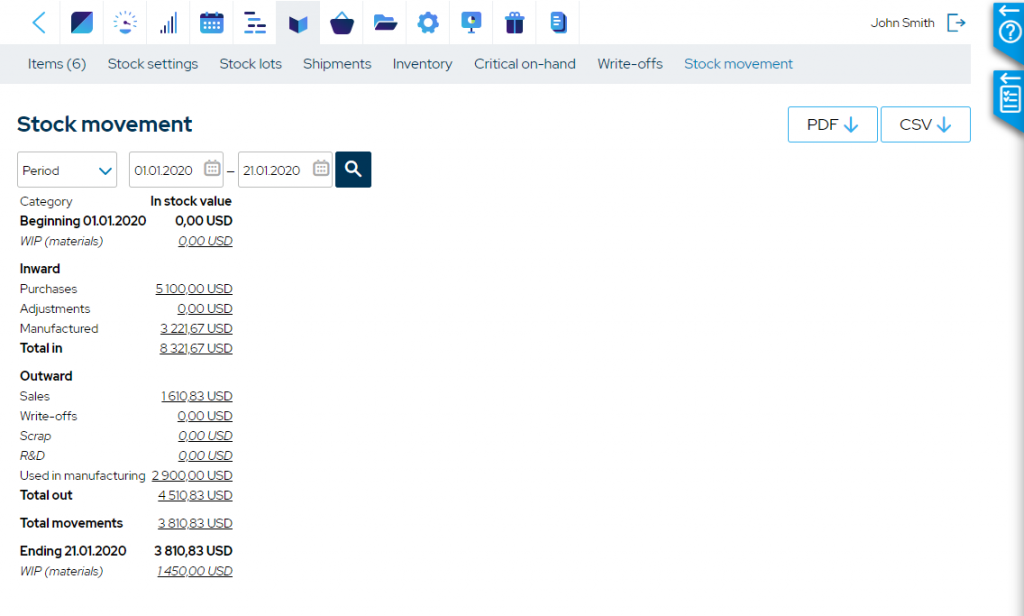Inventory Valuation Methods – Finding the Right Approach
For the financial departments of manufacturing companies, few things are as important as inventory valuation. Due to the effect on the gross profit of a company, choosing the right inventory valuation method is a crucial step in ensuring the financial health of your company.

You can also listen to this article:
What is Inventory Valuation?
Inventory valuation is an accounting procedure that determines the monetary value of unsold inventory stock. Different methods of stock valuation are usually chosen based on how the inventory is used in the manufacturing process and can affect many financial variables of a company. As the two are interlinked in business management, the different techniques are sometimes also called inventory accounting methods.
The valuation given to a company’s inventory can have a direct impact on gross profit. It also affects a company’s taxation and informs stakeholders (like stockholders, owners, or partners) of the true value of the Cost of Goods Sold in a given time period. Cost of Goods Sold (COGS) – the total carrying cost of a product as it is sold within a period of time, has an inverse relationship with gross profit. If a company’s COGS increases, gross profit decreases and vice versa. How the value of inventory is calculated can have an effect on both.
Inventory Valuation Process
The basic flow of inventory value calculation is quite simple. A company begins the accounting period with a beginning inventory valued in monetary units. When net purchases for the period are added, the total value is expressed as a sum called Goods Available for Sale – the total amount of products or inventory that the company has the capacity to sell within the given period. At the end of the period, Goods Available for Sale are broken into two categories – ending inventory and COGS.
Great care must be taken to properly allocate COGS and ending inventory, the reason being that they will appear in different places in a company’s records. The Cost of Goods Sold is subtracted from sales in order to arrive at the company’s gross profit. That value is then reported on the income statement. Ending inventory, on the other hand, is reported on a company’s Balance Sheet and is considered a current asset.
Different Inventory Valuation Methods
Different companies calculate inventory value differently. The type of stock valuation methods used can have a significant effect on the accounting of the company. The choice of which method to use may be based on several factors and it is not uncommon for a company to change the method depending on the market situation. Generally, a company should choose the method that is best for their overall financial health, business strategy, and long-term goals at a given time.
For example, companies who make big-ticket items and fear increasing costs over time may use one method to reduce their taxable income, while others may look to maintain a strong balance sheet to attract investors and qualify for critical CapEx financing.
As every company is different and each method produces different outcomes and is suitable in different situations, choosing the right inventory valuation method for a company’s unique needs is crucial. While there are many different inventory costing methods, we will focus on the five most common ones – FIFO, LIFO, WAC, SE, and FEFO.
First In, First Out (FIFO)
The concept behind FIFO is simple – a company will use its oldest acquired goods first. Because prices of components and other stock may rise over time, using FIFO means that the ending inventory is valued higher because line item valuation costs are higher. This translates into a lower COGS and concurrently higher reported gross profit. It also means a higher taxable income.
FIFO inventory management is simple and can be managed both manually or using an MRP system, depending on the scale of the business. In small and medium-sized businesses, the FIFO method can be tracked manually and then easily migrated into an MRP or ERP system designed specifically for SMBs. FIFO may also be used to comply with financing requirements, depending on whether the company is a discrete or process manufacturer.
Many small process manufacturing companies rely on “factored” financing – a type of bridge loan where the company is loaned short-term (weeks or a few months) financing to cover cash flow when retailers pay on lengthy terms for the goods they purchase. In cases where factoring or short-term bridge loans are used, requirements usually dictate that the amount of short-term cash that can be borrowed against payables can only be up to 80-90% of inventory goods that are 180 days old or less. This usually makes FIFO the best choice for SMBs with a tight cash flow.

Last In, First Out (LIFO)
LIFO is the opposite of FIFO and means that the value of the inventory is expressed as the result of selling the newest goods first. The LIFO inventory method assumes that the cost of the latest units purchased is the first to be allocated to COGS. The main benefit is that gross profit on a company’s income statement is lower and therefore its tax liability is lower as well as taxable income decreases.
Taxation is not the only benefit, however. In addition, LIFO can be used as a hedge against inflation. In uncertain times or in markets with fluctuating prices, LIFO means that companies can match revenues to the latest costs to help them manage price swings. Using the LIFO inventory valuation method also means that a company will have to make fewer write-downs.
Weighted Average Cost (WAC)
WAC is a middle-ground method where the cost of finished goods is divided by the number of inventory units available for sale. Manufacturers may choose the weighted average cost method for several reasons, one being in situations where a company has little variation in its inventory. This can be true for both process and discrete manufacturers such as factories that only produce a single product, a limited line of a specific type of item in high volumes, or a built product with few variations.
Another good idea to opt for WAC is in situations where a company’s systems and processes are not optimized for tracking FIFO and LIFO. SMBs just beginning to scale and whose staff wear many hats may find WAC easier to implement and perfectly adequate for their inventory needs.
A third reason WAC is a good choice for some manufacturers is in cases where inventory is highly commoditized and a cost per unit is very difficult or impossible to assign to individual inventory items. Also, when the differences in item cost are too small to be statistically relevant or when all vendors provide very similar prices.
Finally, WAC is often used in industries where items are highly mixed and cost cannot be assigned per unit. For example, the WAC method would give a good indication of inventory value for a toothpicks manufacturer. This is because the speed of the manufacturing process, the unreliable characteristics of wood at such small sizes, and the possibility of splinters, breakage, and other problems in the manufacturing process would unnecessarily complicate calculating the value of inventory per unit.
Specific Identification (SI)
In a way the opposite of WAC, the Specific Identification method is a good option when inventory value needs to be calculated as precisely as possible. SI requires that all purchases of inventory items and their prices are individually tracked instead of being grouped together. Tracking lots in this way enables high accuracy in inventory cost calculations and is useful when, for example, the inventory consists of a lot of unique high-value items. The SI method is mostly used by SMBs that produce or purvey high-value, custom-made, or unique goods and is easily manageable by either conventional or software-based inventory management systems.
First Expired, First Out (FEFO)
While there are a number of far more specific inventory valuation methods to choose from, the last we will look at is FEFO or First Expired, First Out. FEFO is a necessary option for manufacturers with a high volume, high-speed process that produces perishables – items with a specific shelf life and expiration. This includes dairy, meat, pharmaceuticals, and other consumables that must be used by a specific date. FEFO is a lot like FIFO, except that the guiding principle is to use the expiration date of stock items instead of their arrival to inventory to designate what to use first.
For example, a dairy manufacturer may make cheese with a shelf life of four weeks but also produce milk with a shelf life of only a few days – the expiration date must be considered and inventory lost as a result of spoilage or slow sales accounted for.
Choosing the Right Method
Where a product is manufactured impacts the method of inventory valuation used as well. Manufacturing in the US, companies follow accounting procedures according to Generally Accepted Accounting Principles (GAAP). In most other countries, however, the International Financial Reporting Standards (IFRS) must be used in selecting an inventory costing method. The GAAP inventory valuation guideline allows FIFO, LIFO, SI, and WAC, while the IFRS only recognizes FIFO, SI, and WAC. There are other differences as well, such as how inventory is recorded. Under IFRS, inventory must be recorded as the cost or the net realizable value, or whichever is less, while GAAP recognizes cost or market value, whichever is less.
The inventory costing method chosen by a manufacturer should fit that company’s specific needs. Of course, where they are located will impact that decision but the level of taxation within a country, the variation or volatility of prices within each market, the size and type of the product, the per-unit cost, and other factors will need to be considered as well. Whichever method a company ends up choosing, it is also always a good idea to make sure that it would be easy to implement with the company’s preferred MRP/ERP software.
Key Takeaways
- Inventory valuation is an accounting procedure that determines the monetary value of unsold inventory stock.
- Different companies calculate inventory value differently. The type of stock valuation methods used can have a significant effect on the accounting of the company.
- Choosing the right inventory valuation method for a company’s unique needs is crucial as stock valuation methods are tailored to suit different production practices.
- The five most commonly used inventory valuation methods are FIFO (First In, First Out), LIFO (Last In, First Out), FEFO (First Expired, First Out), Weighted Average, and Specific Identification.
You may also like: Inventory Costs – A Quick Overview




